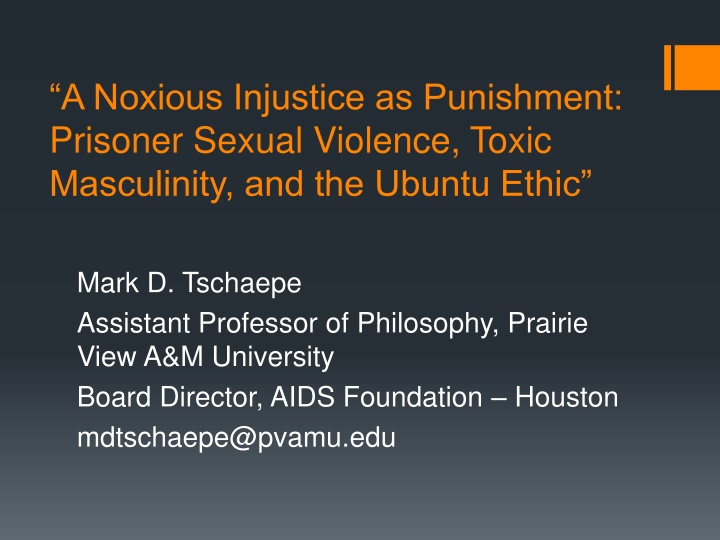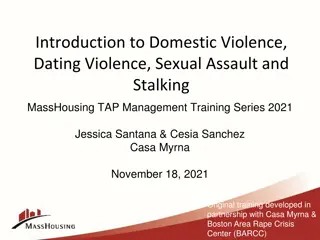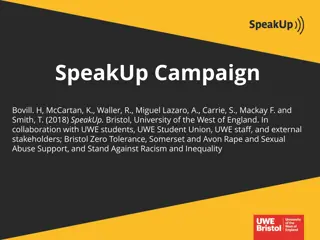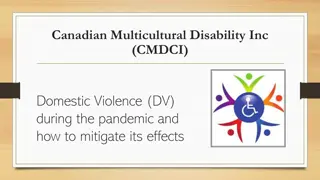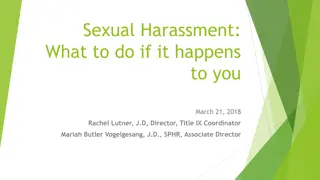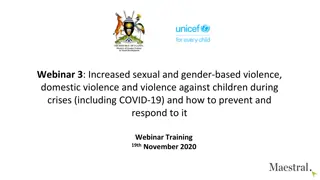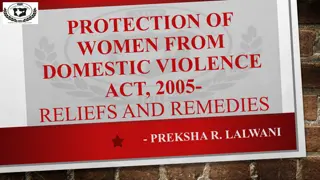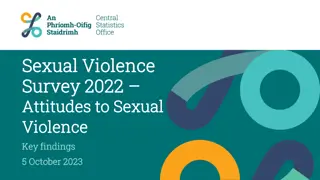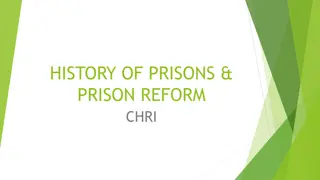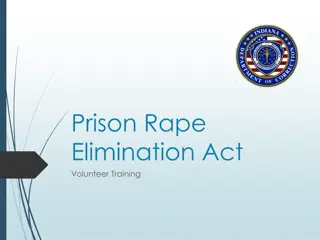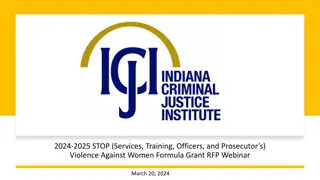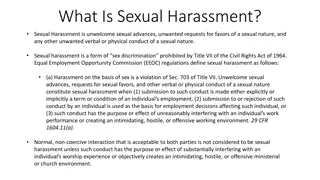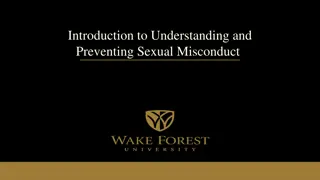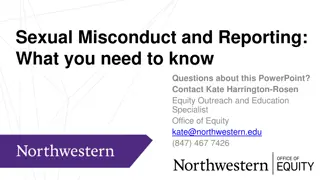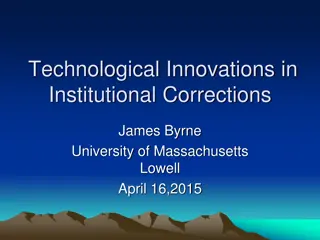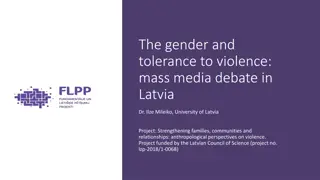Addressing Prison Sexual Violence: Challenges and Solutions
Prison sexual violence is a disturbing reality within the criminal justice system, often dismissed or trivialized. This article sheds light on the prevalence of sexual abuse in prisons, highlighting the staggering statistics and discussing the harmful misconceptions surrounding it. It also explores the efforts and action plans undertaken by states like Texas and Oregon to combat this issue. The narrative emphasizes the urgency of addressing this form of injustice and the necessity of effective interventions to protect incarcerated individuals from such heinous acts.
Download Presentation

Please find below an Image/Link to download the presentation.
The content on the website is provided AS IS for your information and personal use only. It may not be sold, licensed, or shared on other websites without obtaining consent from the author.If you encounter any issues during the download, it is possible that the publisher has removed the file from their server.
You are allowed to download the files provided on this website for personal or commercial use, subject to the condition that they are used lawfully. All files are the property of their respective owners.
The content on the website is provided AS IS for your information and personal use only. It may not be sold, licensed, or shared on other websites without obtaining consent from the author.
E N D
Presentation Transcript
A Noxious Injustice as Punishment: Prisoner Sexual Violence, Toxic Masculinity, and the Ubuntu Ethic Mark D. Tschaepe Assistant Professor of Philosophy, Prairie View A&M University Board Director, AIDS Foundation Houston mdtschaepe@pvamu.edu
Socrates: Is it, then, the role of the just man to harm anyone? Polemarchus: Certainly, he must harm those who are both bad and enemies. Republic, 335b
Prison Sexual Violence Commonly the subject of jokes and exploitation (e.g. television shows) Assumed to be part of the punishment by many, especially those in law enforcement Thought to be justified by many as a form of just deserts, especially when the incarcerated person has committed a sexual crime (e.g. pedophilia) Principle of Just Desert (Rachels 1997)
General statistics As of 2011: 1,487,393 males in state and federal penitentiaries (USDJ, 2012) In 2003, Congress estimated that 13% of all inmates would be sexually assaulted while incarcerated Congress also estimated that the total number of prisoners who had been sexually assaulted between 1981 & 2001 was over 1 million (PREA, 42 USC 15601)
Push to End Prison Rapes Loses Earlier Momentum By DEBORAH SONTAG, MAY 12, 2015, NY Times.
2 cases Texas 3rd largest prison system in the U.S. (2005: 123,494 male inmates) Even racial distribution between Blacks, whites, & Hispanics 2005: highest reported PSV (3.95 per 1000 prisoners; national average: 1.05 per 1000 prisoners) Lowest rate of substantiation: <3% Assailants: 68% Black Victims: 60% white Oregon 2005: 11, 847 male inmates 80% of inmates are white 2004: 16 allegations of PSV (1.26 per 1000 prisoners) 5 substantiated cases Assailants: incarcerated for violent offenses Victims: incarcerated for non- violent and/or sexual offenses No racial component detected
Action plans Texas Oregon 2001: Safe Prison Program established Strategies include: education, housing assignments, facility enhancements, system of classification Collaboration with AIDS Foundation Houston, Wall Talk Visual Tracking Grid system identifies blind spots Department of Corrections works closely with Partnership for Safety & Justice PREA action plan includes: staff training inmate education, victim services, response and investigation practice, monitoring components Cellmate Program (computer program for roommate assignment)
Major differences Texas Wall Talk peer counseling program Blame the victim culture E.g. Allred maximum security prison 2008-2009: 66 investigations of PSV (3600 inmates) 0 charges were sustained Evident homophobia among staff Oregon Training includes: information concerning victim rights, unacceptable behaviors surrounding PSV, consequences of false reporting, issues of confidentiality Greater effect on prison culture
Texas Case: Passion Star 10/23/14: Lambda Legal sues TCDJ officials on behalf of inmate, Passion Star (last name: Zollicoffer) Passion Star is a transgendered female who had been harassed by both inmates and TCDJ officials since being incarcerated in 2003 She had been raped on multiple occasions in the 6 male prisons in which she was housed Her complaints and grievances were ignored by TCDJ officials
Texas Case: Passion Star At the end of March, 2015, TDCJ finally agreed to place Passion Star in Safekeeping to protect her from further sexual assaults and threats The case against TDCJ officials is still in progress and was amended to include sexual violence committed against Passion Star during the trial that began in October Cases such as Passion Star s could be avoided completely by providing housing based upon gender identity and safety considerations, as well as providing training to personnel and incarcerated persons to change the prison culture
Toxic Masculinity the constellation of socially regressive male traits that serve to foster domination, the devaluation of women, homophobia, and wanton violence (Kupers 2005, 714) Systemic issues of homophobia and race are subsets of a larger issue of masculine norms
Toxic Masculinity 4 structural elements of the prison code (Kupers 2010, 112): 1. There is an exaggerated dominance hierarchy wherein the toughest men dominate those who are less tough. 2. There is a sharp demarcation between those at the top of the dominance hierarchy and those at the bottom. 3. When one man beats up another and sodomizes him, the message is clear: I, the dominant man, have the right and the power to use you, the loser, sexually, as if you were a woman and my slave . 4. There is a narrowing of personal possibilities, and men are forced to act in hyper-masculine and dominating ways merely to prove they are not feminine, they are not anyone s punk .
A Poisonous Culture The prison code is based upon the idea that whatever one gets, that is what one deserves because of weakness An extreme system of de/value is established Toxic masculinity and its effects are reinforced outside of the prison through, inter alia: o Bullying o Homophobia o Transphobia o Sexism o Rape culture o Body shaming o Racism o Classism o Ableism o Disease-based discrimination (e.g. HIV- discrimination) o Status-based microaggressions
Ubuntu the individual person is not an atomistic being that is primarily separated from all others the individual person is born from and within a community of persons, as well as the traditions, mores, and values of the community This fundamental idea of the person is captured by the proverb from the Nguni languages of Zulu, Xhosa, and Ndebele, umuntu ngumuntu ngabantu, which translates as a person is a person through other persons or I am because we are.
Ubuntu & PSV Punishment for criminal activity is understood as an attempt to reconcile the disharmony within the community, which is in contradistinction to the purpose of punishment as retribution or retaliation. Punishment for criminal activity, in order to be just, must provide and perpetuate harmony rather than disharmony. The belief in PSV as a form of just desert betrays the ethic of Ubuntu.
Ubuntu & PSV 1. By injuring and alienating a person from the community, rather than facilitating harmony between the community and the person who has engaged in criminal activity, that person is further separated from the community. The injustice of the initial criminal act is thereby increased through PSV. 2. Because PSV further separates the individual from the community, both that individual and those in the community stray from personhood. Not only is justice diminished, but personhood is also diminished.
Ubuntu & PSV 3. As indicated through understanding how PSV contributes to and perpetuates toxic masculinity, the community is further dehumanized by trickle- down toxicity. The effects of PSV are not restricted to what occurs within prison walls, but expand into the community, corroding harmony and solidarity.
Ubuntu & PSV Ubuntu does not delimit moral responsibility and punishment to persons as atomistic entities primarily separated from the community. PSV is revealed as an unjust feature not just of prisons, but of the communities that build and sustain those prisons.
Using Ubuntu to end PSV The Khanyisa program in rural KwaZulu-Natal, South Africa is a useful model. Khanyisa has focused specifically on transforming the internalized social structure of masculine domination that perpetuates toxic masculinity and works against the well-being of the community. Through peer-based group work with 8 males over a 12-month span, the concept of Ubuntu was introduced as an ethic directed within others, within self, and within community.
Using Ubuntu to end PSV Through interviews following the 12-month program, the Khanyisa group has indicated that Ubuntu training may help ameliorate the damaging beliefs and behaviors correlated with masculinity. My wish is to live Ubuntu and to practice Ubuntu without even thinking about it, I want it to be a part of me, a part of my blood, something that I do automatically without even thinking about it. I think it is important to use Ubuntu because it s like a pillar. You can use Ubuntu to discuss gender based violence, you can use it to discuss HIV and AIDS, you can use Ubuntu to discuss a lot of different things
Using Ubuntu to end PSV Structures and services are in place by which an ethic of Ubuntu may be introduced into U.S. men s prisons in order to transform the culture. Since the 2003 Prison Rape Elimination Act (PREA), the government has implemented various programs meant to curb PSV. The National PREA Resource Center provides webinars for increasing prevention, detection, monitoring, responses to incidents, and services to victims and their families.
Using Ubuntu to end PSV Programs, such as Wall Talk, a peer-education program utilized by AIDS Foundation Houston to help stop the spread of HIV in prisons, could benefit from the Ubuntu components of the Khanyisa program as a means by which to transform prison culture and beyond, reversing the trend of trickle- down toxicity over the long term.
Conclusion Prison sexual violence must be stopped. To neglect the fight against prison sexual violence and toxic masculinity is not only to perpetuate injustice, but it is to betray and denigrate personhood.
Citations & Recommendations available upon request Email: mdtschaepe@pvamu.edu
Austin, J. et al. 2006. Sexual Violence in the Texas Prison System. Washington, D.C.: The JFA Institute. Cotton, D.J. and A.N. Groth. 1982. Inmate rape: Prevention and Intervention. Journal of Prison and Jail Health 2(1): 47-57. Dallao, M. 1996. Fighting prison rape: How to make your facility safer. Corrections Today 58(7). Fishman, J.F. 1934. Sex in Prison: Revealing sex conditions in American prisons. New York: National Library. Glanz, K., Rimer, B. and K. Viswanath. 2008. Health Behavior and Health Education: Theory, Research, and Practice, 4th Ed. San Francisco, CA: Jossey-Bass. Human Rights Watch (HRW). 2001. No Escape: Male Rape in U.S. Prisons. http://www.hrw.org/reports/2001/prison/index.htm Last Accessed: 25 October 2014. Kupers, T. 2005. Toxic Masculinity as a Barrier to Mental Health Treatment in Prison. Journal of Clinical Psychology 61: 713-724. Kaufman, P. 2010. Prison Rape: Research Explores Prevalence, Prevention. National Institute of Justice 259: 24-29. LaVigne, N. et al. 2011. Preventing Violence and Sexual Assault in Jail: A Situational Crime Prevention Approach. Urban Institute Justice Policy Center. December. www.urgan.org LGBTI. 2010. Preventing the Sexual Abuse of Lesbian, Gay, Bisexual, Transgender, and Intersex People in Correctional Settings. Comments Submitted in Response to Docket No. OAG-131; AG Order No. 3143-2010, National Standards to Prevent, Detect, and Respond to Prison Rape. 10 May 2010. Peek, Christine. 2004. Breaking Out of the Prison Hierarchy: Transgender Prisoners, Rape, and the Eighth Amendment. Santa Clara Law Review 44: 1211-1248. PREA Resource Center. Crafting Your Program: PREA and Inmate Education in Jails. Session 2 of 2. 28 May 2013. http://www.prearesourcecenter.org/sites/default/files/library/inmateedforjails2webinarmaster.pdf Last Accessed: 25 October 2014. Rape is not part of the penalty. OregonLive. http://www.oregonlive.com/opinion/index.ssf/2009/06/rape_is_not_part_of_the_penalt.html Posted: 21 June 2009; Updated: 19 October 2009. Last Accessed: 25 October 2014. Roling, C. 2010. Making the Road by Walking It Ten Years on the Road with PSJ. Partnership for Safety and Justice. http://www.safetyandjustice.org/news/making-road-walking-it-%E2%80%93-ten-years-road-psj Posted: 23 April 2010. Last Accessed: 22 October 2014. Struckman-Johnson, Cindy and Dave Struckman-Johnson. 2013. Stopping Prison Rape: The Evolution of Standards Recommended by PREA s National Prison Rape Elimination Commission. The Prison Journal 93: 335-354. DOI: 10.1177/0032885513494567. U.S. Congress. 2003. Prison Rape Elimination Act of 2003. Public Law 108-79-Sept. 4, 2003. 42 USC 15601-15609. U.S. Department of Justice. 2012. Report on Sexual Victimization in Prisons and Jails: Review Panel on Prison Rape. www.ojp.usdoj.gov/reviewpanel/reviewpanel.htm Last Accessed: 25 October 2014. U.S. Department of Justice. 2014. PREA Data Collection Activities. Office of Justice Programs, Bureau of Justice Statistics. Villarreal, D. 2012. Welcome to Texas, prison rape capital of the U.S. Dallasvoice.com: The Premier Media Source for LGBT Texas. http://www.dallasvoice.com/texas-prison-rape-capital-u-s-10105138.html Posted: 22 Mar 2012. Last Accessed: 25 October 2014. Zaitz, L. 2012/2014. Abuse of women inmates at Oregon s Coffee Creek prison goes on for years. OregonLive. http://www.oregonlive.com/politics/index.ssf/2012/04/abuse_of_women_inmates_at_oreg.html Posted: 29 April 2012; Updated: 10 May 2014. Last Accessed: 25 October 2014. Zweig, J.M. et al. 2007. Addressing Sexual Violence in Prisons: A National Snapshot of Approaches and Highlights of Innovative Strategies, Final Report. Washington, D.C.: Urban Institute Justice Policy Center
Bozelko, C. 2015. Why We Let Prison Rape Go On. New York Times April 18: A19. Chuwa, L. (2014). African Indigenous Ethics in Global Bioethics: Interpreting Ubuntu. Dordrecht: Springer. Buffum, P.C. 1972. Homosexuality in Prison. U.S. Department of Justice, Law Enforcement Assistance Administration, National Institute of Law Enforcement and Criminal Justice. Washington, D.C.: Government Printing Office. Connell, R. and James W. Messerschmidt. (2005). Hegemonic Masculinity: Rethinking the Concept. Gender and Society. 19(6): 829-859. Capers, Bennett. (2011). Real Rape Too. 99 California Law Review 1259. Dewey, John. (1927). The Public and Its Problems. New York: Henry Holt & Co. Drieschner, K. and Alfred Lange. (1999). A Review of Cognitive Factors in the Etiology of Rape: Theories, Empirical Studies, and Implications. Clinical Psychology Review. 19(1): 57-77. Dumond, Robert W. (2006). The Impact of Prisoner Sexual Violence: Challenges of Implementing Public Law 108-79, The Prison Rape Elimination Act of 2003. Journal of Legislation. 32: 142-164. Eigenberg, H. (2000). Correctional officers definitions of rape in male prisons. Journal of Criminal Justice. 28: 435-449. Eze, M.O. (2008). What is African Communitarianism? Against consensus as a regulative ideal, South African Journal of Philosophy, 27/4: 387. Fishman, J.F. (1934). Sex in Prison: Revealing sex conditions in American prisons. New York: National Library. Gear, S. (2007). Behind the Bars of Masculinity: Male Rape and Homophobia in and about South African Men s Prisons. Sexualities. 10: 209-227. Ghanotakis, E., Bruins, M., Peacock, D., Redpath, J., and Swart, R. (2007). Stop prison rape in South Africa. Agenda. 74: 68-80. Graybill, Lyn S. (2002). Truth & Reconciliation in South Africa: Miracle or Model? Boulder, CO: Lynne Rienner Publications. Karpman, Benjamin. (1948). Sex Life in Prison. Journal of Criminal Law and Criminology. 38(5): 475-486. Kupers, T. (2005). Toxic Masculinity as a Barrier to Mental Health Treatment in Prison. Journal of Clinical Psychology. 61(6): 713-724. Kupers, T. (2010). Role of Misogyny and Homophobia in Prison Sexual Abuse. UCLA Women s Law Journal. 18(1): 107-130. Levan, K., Polzer, K., and Downing, S. (2011). Media and Prison Sexual Assault: How We Got to the Don t Drop the Soap Culture. International Journal of Criminology and Sociological Theory. 4(2): 674-682. Levine, M. (1998). Gay Macho: The Life and Death of the Homosexual Clone. New York: New York University Press. Man, Christopher D. and John P. Cronan. (2001). Forecasting Sexual Abuse in Prison: The Prison Subculture of Masculinity as a Backdrop for Deliberate Indifference . The Journal of Criminal Law & Criminology. 92(1): 127-185. Marx, Christoph. (2002). Ubu and Ubuntu: On the dialectics of apartheid and nation building. Politikon: South African Journal of Political Studies. 29(1): 49-69. DOI: 10.1080/02589340220149434. 17 Metz, Thaddeus. (2014). Just the beginning for ubuntu: reply to Matolino and Kwindingwi. South African Journal of Philosophy. 33(1): 65-72. Metz, Thaddeus. (2007). Toward an African Moral Theory. The Journal of Political Philosophy 15(3): 321-341. Metz, Thaddeus and J. B. R. Gaie. (2010). The African ethic of Ubuntu/Botho: implications for research on morality. Journal of Moral Education 39 (3): 274. Nacci, Peter L. and Thomas R. Kane. (1983). The Incidence of Sex and Sexual Aggression in Federal Prisons. Federal Probation.47: 31- 36. O Donnell, I. (2004). Prison Rape in Context. British Journal of Criminology. 44: 241-255.
Plato. (1992). Republic. Indianapolis, IN: Hackett Publishing Co. Okolo, Chukwudum B. (2003). Self as a Problem in African Philosophy, in P.H. Coetzee and A.P.J. Roux (eds), The African Philosophy Reader, Second Edition, (London and New York: Routledge), pp. 209 215. PREA Resource Center. Crafting Your Program: PREA and Inmate Education in Jails. Session 2 of 2. 28 May 2013. http://www.prearesourcecenter.org/sites/default/files/library/inmateedforjails2webinarmaster.pdf Last Accessed: 25 October 2014. Rachels, J. (1997). Punishment and Desert. In H. LaFollette (Ed.), Ethics in Practice (pp. 470-479). Oxford: Basil Blackwell. Ramose, Mogobe B. (2003). The ethics of ubuntu, in The African Philosophy Reader, Second Edition, eds. P.H. Coetzee and A.P.J. Roux (New York: Routledge) Robertson, James E. (1999). Cruel and Unusual Punishment in the United States Prisons: Sexual Harassment Among Male Inmates. The American Criminal Law Review 36(1): 1-51. Sigler, Mary. (2006). By the Light of Virtue: Prison Rape and the Corruption of Character, 91 Iowa Law Review 561. Tutu, Desmond. (1999). No Future Without Forgiveness. London: Rider. U.S. Department of Justice. (2012). Report on Sexual Victimization in Prisons and Jails: Review Panel on Prison Rape. Retrieved October 25th, 2014, from www.ojp.usdoj.gov/reviewpanel/reviewpanel.htm U.S. Congress. (2003). Prison Rape Elimination Act of 2003. Public Law 108-79-Sept. 4, 2003. 42 USC 15601-15609. Walmsley, R. (2013). World Prison Population List, 10th Ed. London: International Centre for Prison Studies. Wiredu, K. (1996) Cultural Universals and Particulars: An African Perspective Bloomington: Indiana University Press. York, Matt. (2014). Transforming Masculinities: A Qualitative Study of A Transformative Education Programme for Young Zulu Men and Boys in Rural Kwazulu-Natal. The Journal of Pan African Studies 7(7): 70. Zweig, J.M., Naser, R., Blackmore, J., and Schaffer, M. (2007). Addressing Sexual Violence in Prisons: A National Snapshot of Approaches and Highlights of Innovative Strategies, Final Report. Washington, D.C.: Urban Institute Justice Policy Center.
